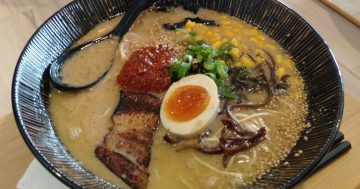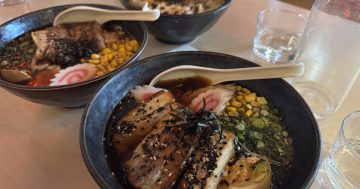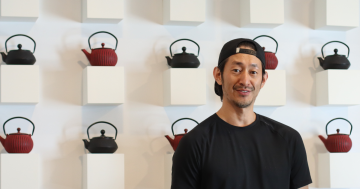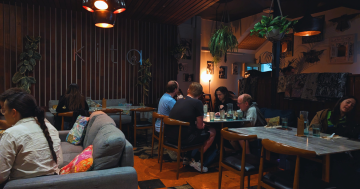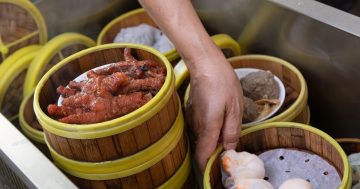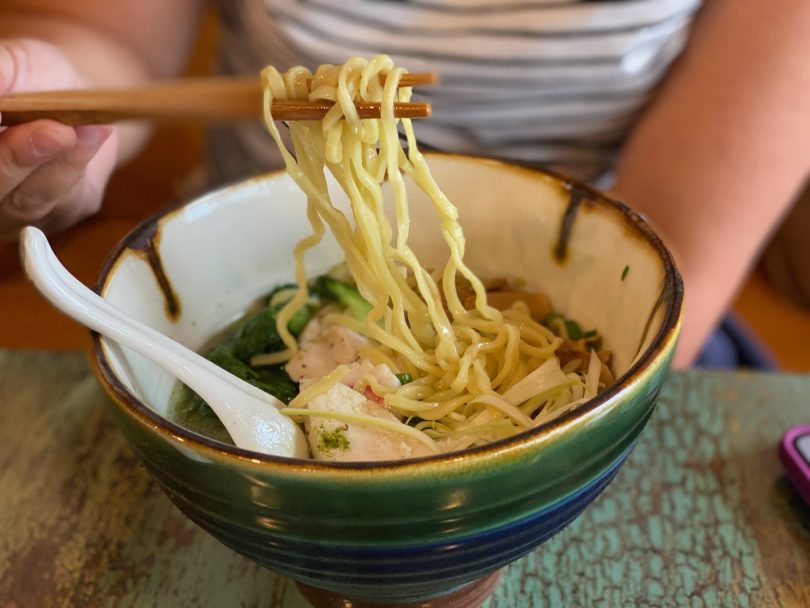
House-made noodles and deep, flavoursome broths are hallmarks of Ohsama Ramen in Manuka. Photo: Michelle Rowe.
My all-time favourite food film is the 1985 “ramen western” Tampopo. In it, hapless heroine Tampopo, lumbered with a failing ramen shop and lacklustre cooking skills, is taken under the wing of a pair of passing truck drivers who deem her noodles “sincere, but lacking in guts”.
The threesome, along with a supporting cast of food-obsessed characters in their own whimsical side stories, set off on a quest to find the secret to preparing the perfect ramen. Once cracked, it will surely reverse the struggling widow’s fortunes … and those of her unlikely saviours.
But what IS the perfect ramen? To delve too deeply into the intricacies of Japanese noodle soup making could well be the road to madness. Like any nation with a long culinary history, there are regional variations, of course.
Then there’s the soup base to consider. Is shio (salt-based) superior to shoyu (soy sauce-based)? Why is it that tonkotsu, all pork bone and collagen, seems to get a better rap than the less-confronting miso-flavoured version?
And even if you successfully navigate the broth conundrum, what about the noodles? Thick or thin? Wavy or straight? Yellow and sturdy, or something that floats about daintily like a lace handkerchief lost in a sea of chicken stock? And choosing the right topping could drive a person to drink.
I’m on my way to Ohsama Ramen, newly opened in a small laneway in the heart of Manuka, and hope to gain a deeper understanding of the ins and outs of this most traditional of Japanese dishes.
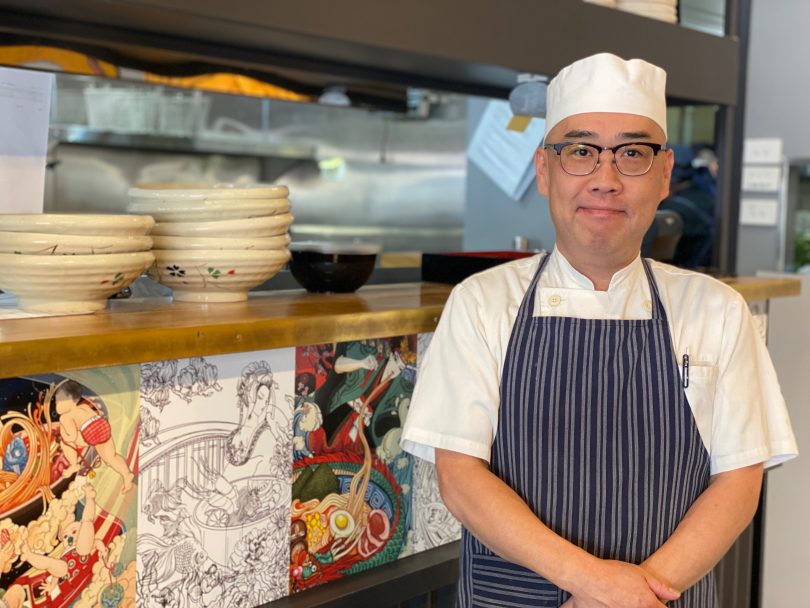
Chef Yuji Takeda has had a distinguished and varied career in Japan and Australia. Photo: Michelle Rowe.
Tokyo-born Yuji Takeda knows a thing or two about the food of his home country. He comes from a long line of sushi makers, but rather than continue the family legacy, Yuji ran successful French and Italian restaurants in the Japanese capital before moving to Canberra two decades ago. Here, he made a name for himself running the popular hole-in-the-wall Tasuke sushi and noodle bar in the Sydney Building for many years.
Yuji was on a brief hiatus when enterprising restaurateur Vivian Xiao, who knows versatility when she sees it, lured him back into the kitchen to head up Ohsama Ramen, which she opened in Palmerston Lane, just behind Manuka Court, less than a month ago. Today, ramen is very much Yuji’s game.
“Yuji knows the traditional way to make ramen – it can take up to eight hours. He also has French, Italian and Korean influences. He’s a genius,” Vivian says of her star recruit.
The experienced chef is not Vivian’s only secret weapon. In a small alcove beside the open kitchen sits a gleaming silver contraption featuring levers and rollers and myriad knobs and buttons, as well as a fair dusting of flour. Two members of the kitchen team are giving it their utmost attention as it cranks out what appears to be a perfectly formed sheet of pastry.
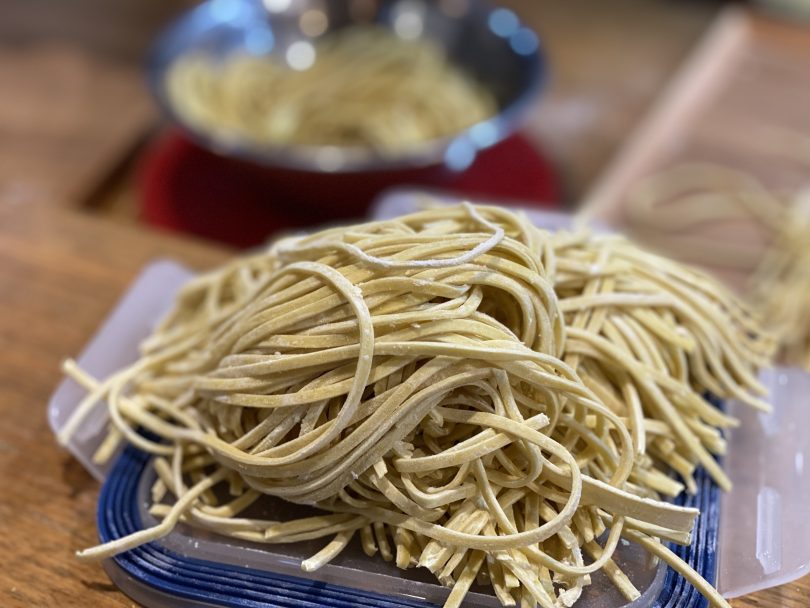
Freshly made noodles come in a variety of sizes, according to their intended use. Photo: Michelle Rowe.
In fact, it’s a top-of-the-line noodle-making machine imported from Japan for a not inconsiderable sum. Being able to make all their noodles from scratch in-house, rather than buying them from a third-party supplier, is worth every cent of the investment, Vivian explains.
“Yuji was in complete agreement that we didn’t want to use [readymade noodles]. We wanted to serve the best we can possibly serve – and that meant making our own,” she says.
Little more than flour, gluten, salt, water and perhaps a bit of gardenia pollen to add a splash of colour, goes into the machine before the ingredients are mixed, stretched and rolled, then cut into just the right size of noodle.
Getting one’s noodles the right size is, naturally, integral to the success of one’s ramen noodle soup, as is consistency. Every bowl of soup at Ohsama Ramen contains precisely 150 grams of noodles (dry weight) and 400 ml of broth, says Vivian.
Yuji’s Sama Tori Chicken Ramen, with its light and clear broth and nuanced flavours, requires a thin and delicate noodle.
His Jiro Tonkotsu Ramen, on the other hand, a rich and creamy pork broth cooked for a full day and topped with thick slices of soy-braised pork belly, sweet soy poached egg, black fungus, roasted sesame and black garlic oil, needs a robust noodle to stand up to the bold flavours.
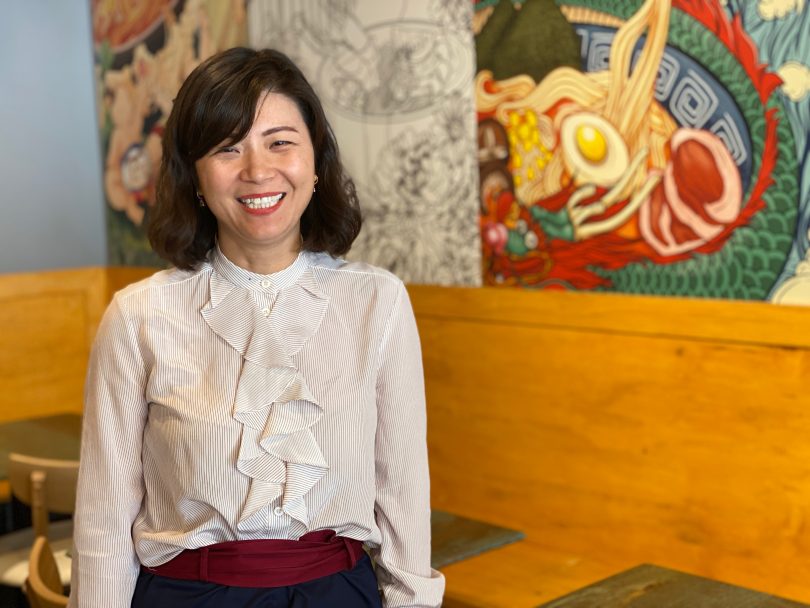
Ohsama Ramen owner Vivian Xiao at her new Manuka restaurant. Photo: Michelle Rowe.
Then there are the sturdy little yellow noodles, just firm enough to be used for dipping or in salads.
Noodle dipping, says Vivian, is something customers are still getting used to. The restaurant’s Tonkotsu Tsukemen Dipping Style Ramen comes with soup and noodles served separately but, despite the hint in the name, “people have no idea how to eat it”, she says.
The noodles and their topping of braised pork belly, egg and vegetables should be dipped into the accompanying broth to soak up the deep flavours of shallot, roasted sesame and black garlic oil before being popped in the mouth, Vivian explains.
Ohsama Ramen’s menu is relatively short, which is perhaps a blessing for the team trying to get their heads around the intricacies of the noodle machine, and diners still grappling with the concept of noodle dipping.
There are four versions of ramen soup and two styles of sashimi (the spicy salmon don is thoroughly recommended for those who like a sucker-punch of chilli with their diced salmon sashimi, served with sliced prawns and sesame seeds on top of satisfyingly sweet sushi rice). There’s also a soba salad; grilled eel on steamed or sushi rice; and pan-fried braised pork belly tossed with green shallots and finished with homemade teriyaki sauce.
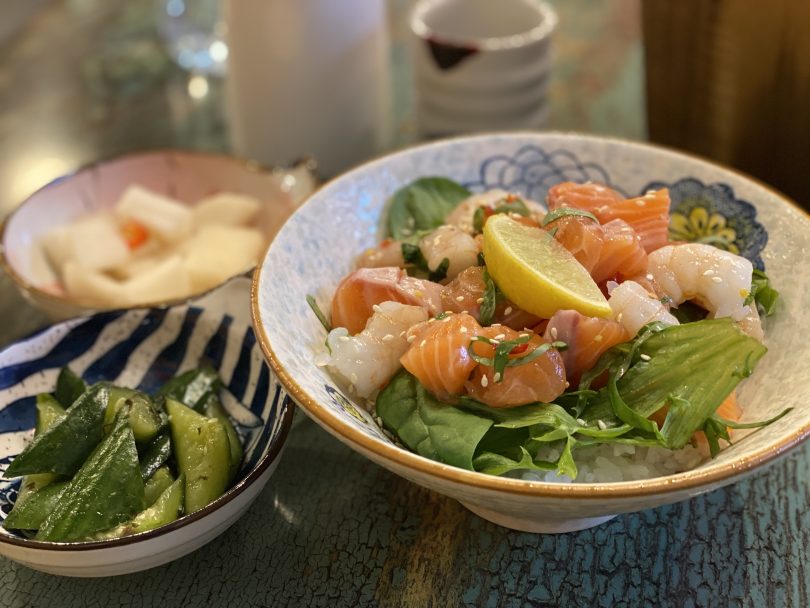
The Spicy Salmon Don packs a chilli punch, as do the pickles, which change daily. Photo: Michelle Rowe.
A list of five side dishes runs the gamut of edamame and okonomiyaki Japanese pancakes to fried chicken, while a rotating cast of pickles means you might get the cucumber with plum sauce one day or a serve of piquant pickled radish the next.
The restaurant’s interiors are cool and contemporary. Colourful sketches and drawings line the walls, and an enormous metal table runs the length of the room. In a former life, it was an industrial desk; today, it seats 34 people for lunch or dinner. Tables for two and four sit against the wall opposite the open kitchen.
“We didn’t want a small space where you have to eat fast and leave. We want people to stay and enjoy the food,” says Vivian, who believes trial and error is the key to getting things right.
She intends to spend the first three months of the restaurant’s life listening to customer feedback – tweaking recipes, deleting non-starters and adding new ideas before locking in a permanent menu that has been proven to hit the spot with diners.
I can see the menu transition happening before my eyes. On my first visit to Ohsama Ramen, just three weeks earlier, I tried a delicious bowl of Jiro-style Tokyo noodles – a light but flavoursome broth crowned with generous slices of tender pork, fishcake and vegetables.
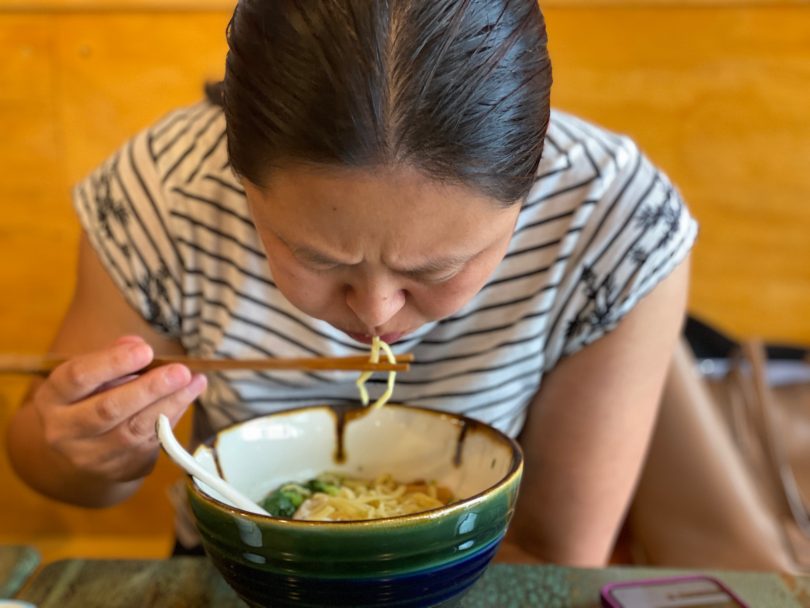
Perfect concentration is needed when tucking into a bowl of Japan’s most famous soup. Photo: Michelle Rowe.
On my second trip, the Tokyo version had been replaced with Tonkotsu-style ramen from the Island of Kyushu in Japan’s south – its creamier, richer broth made of chicken and pork bones is simmered for hours with herbs and vegetables.
I ask Yuji, who has made it clear his allegiance lies squarely with the Tokyo version, what’s behind the change. It turns out customers just like Tonkatsu – it’s something we’re more familiar with.
But this is not the end of the matter. Having been in the restaurant business longer than most, Yuji is a patient man. “When people travel, they will get to know many other styles of ramen. In future, we’ll get the Tokyo ramen back on the menu,” he says confidently. Tokyo style ramen … with just a little hint of French and Italian, via Canberra, perhaps.
Ohsama Ramen, at 5 Palmerston Lane, Griffith, is open for lunch and dinner, Monday to Saturday. Phone 6295 2221.
Original Article published by Michelle Rowe on The RiotACT.


